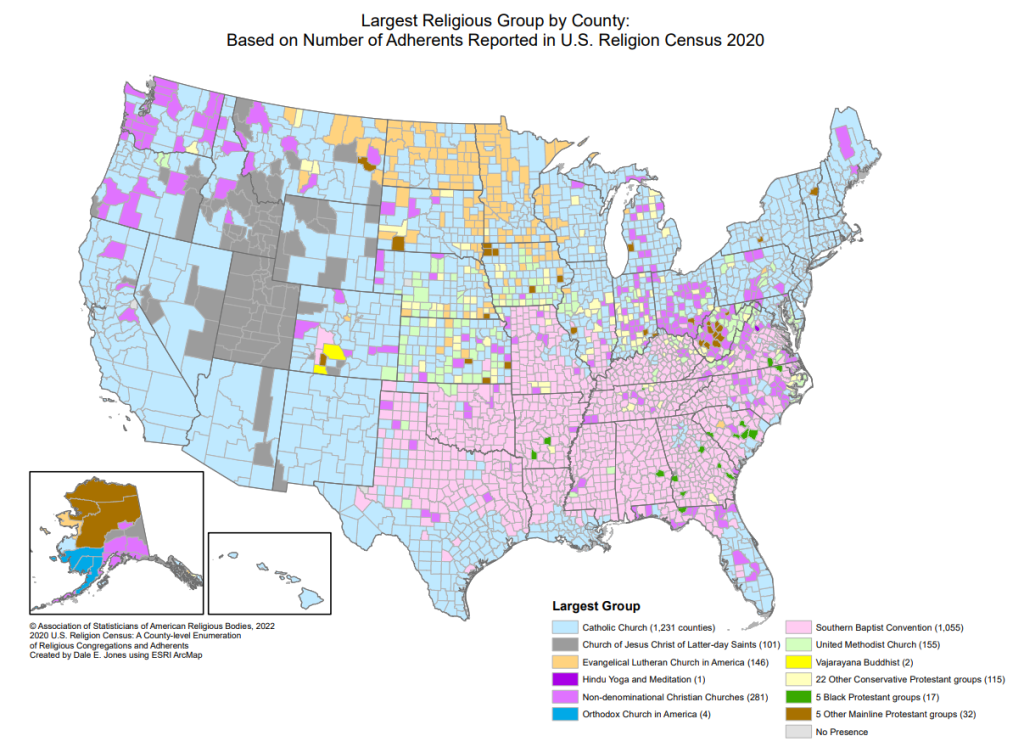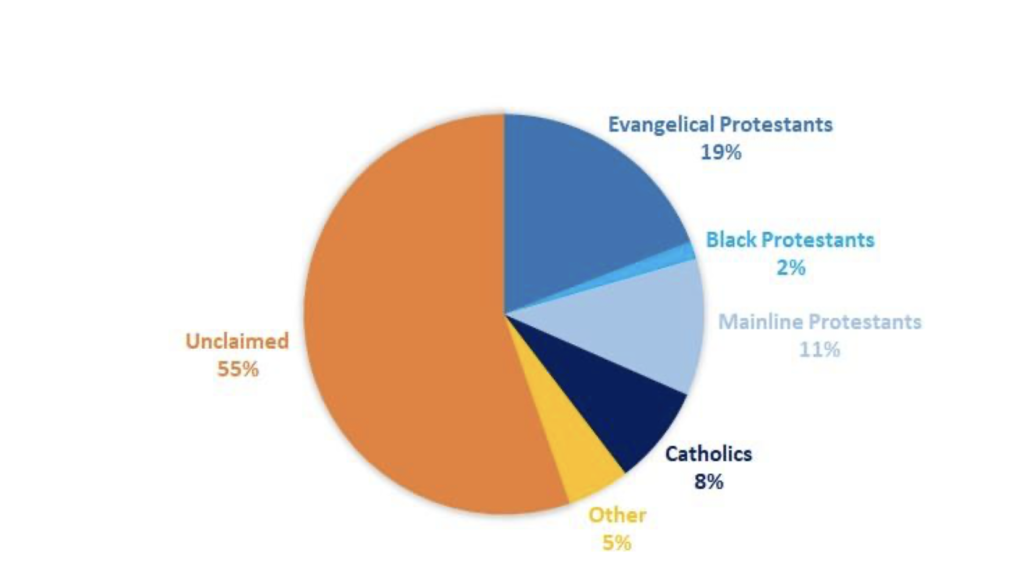Chapter 8: The Geography of Religion
8.5 Religion in the United States
8.5.1 Distribution of the Major Religions and Their Denominations in the US

Source: “Largest Religious Group by County” by U.S. Religion Census.
The map above in Figure 8.5.1 shows the largest religious groups collected by the US Religion Census in 2020 within the United States by county. Data on religious identity is often collected either by polling individuals (who may or may not identify with a religious tradition) or by surveying religious institutions and their affiliated membership. The U.S. Religion Census, accessible through the Association of Religious Data Archives (ARDA), provides a glimpse of the overall religious landscape and focuses on the rich tapestry of practitioners (congregations and adherents3) across the country.
Before European colonization of the Americas, there were myriad indigenous religions practiced by Native Americans. The colonists brought various forms of Christianity to the Americas. Christian branches and protestant denominations were not randomly distributed, but rather clustered along denominational lines in certain colonies or regions. In the New England colonies, Congregationalists were most prominent. Southern colonists were largely Anglican (or Episcopalian as it became known after the American Revolution). The colony of Maryland was chartered for Catholics. As more people migrated and more churches were founded, these early patterns of regional domination by particular denominations changed. Three major changes caused this diffusion and confusion of American religion:
- American-style freedom, which encouraged experimentation of spiritual matters and departure from establishment churches
- Westward expansion, where new and eclectic worship practices developed in the vacuum of established churches
- Immigration, as new migrants to the United States held on to the security of their homeland’s religious practice
As a result, there are few counties in the United States that have a single, dominant religion. The map above shows the religious diversity in the United States by county. There are four general ‘dominant’ or pluralistic regional religions in America, as seen in the map:
- Baptists in the South
- Lutheranism in the Upper Midwest
- Catholicism in the Northeast and the West
- Mormonism around Utah and southern Idaho
The Catholic patterns come from two different patterns of migration. Those mostly urban strongholds in the Northeast were started from European Catholic migration of Ireland, Italy, and other European countries. The West is largely influenced from Hispanic or Latinix immigration.
8.5.2 Changes in Religiosity – Secularization
According to the Pew Center just a few decades ago, being Christian was almost a given for Americans, with about 90% identifying as such in the early 1990s. However, today, that number has decreased to about two-thirds of adults. This shift in America’s religious demographics is primarily due to a significant number of adults leaving their childhood religion to become religiously unaffiliated. In essence, fewer young adults who were raised Christian have maintained their religious identity into adulthood over the past three decades.
Reasons for these findings abound: There are numerous theories explaining the accelerated disaffiliation in the 1990s and speculating on its future trajectory. For instance, some scholars argue that secularization has been fueled by increased “existential security”—as societal conditions improve and scientific advancements alleviate concerns about basic needs, there is less reliance on religion for coping with insecurity. Others suggest that in the U.S., the association of Christianity with conservative politics has alienated many liberals from the faith. Additional theories point to declining trust in religious institutions, scandals involving clergy, rising rates of interfaith marriages, smaller family sizes, and various other factors. According to Pew Research Center, Americans cite a wide array of reasons for abandoning their religious affiliations.
The map below shows the largest religious groups collected by the US Religion Census in 2020 within the United States by county. Data on religious identity is often collected either by polling individuals (who may or may not identify with a religious tradition) or by surveying religious institutions and their affiliated membership. The U.S. Religion Census, accessible through the Association of Religious Data Archives (ARDA), provides a glimpse of the overall religious landscape and focuses on the rich tapestry of practitioners (congregations and adherents3) across the country.
8.5.3 Religion in Virginia
In Virginia, religious affiliation varies widely among residents. According to the pie chart below, (Figure 8.5.1) 55% of Virginians do not identify with any specific religious institution such as a church, synagogue, or mosque, although some may still consider themselves religious. Evangelical Protestants make up 19% of the population, Mainline Protestants 11%, and Catholics 8%. The remaining 5% belong to the “Other” category, which includes various non-Christian religions practiced in Virginia, such as Buddhism, Hinduism, Judaism, Mormonism, and Islam.

Source: “Figure 1: Largest Non-Christian Religious Group by State in 2010” from “Who Practices What Religion Where in Virginia?” By Shonel Sen and Rebecca Draughon, Weldon Cooper Center for Public Service, University of Virginia.

